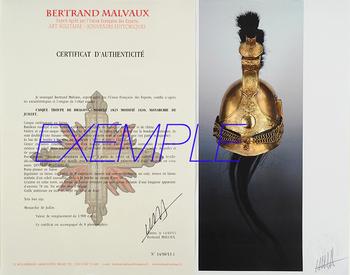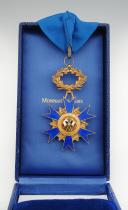
COMMANDER'S CROSS OF THE NATIONAL ORDER OF MERIT, Fifth Republic. 26416-11
Sold out
COMMANDER'S CROSS OF THE NATIONAL ORDER OF MERIT, Fifth Republic. 26416-11
Made of gilded brass, with a six-pointed star double-enameled in blue. The center features the head of the republic with a laurel wreath and the inscription "RÉPUBLIQUE FRANÇAISE" on the obverse, and on the reverse, two enameled French flags with the inscription "ORDRE NATIONAL DU MÉRITE 3 DÉCEMBRE 1963." The suspension loop is formed by a crown of two laurel branches. Dimensions: Height 8.6 cm, Diameter 5.4 cm.
Complete with its blue ribbon, presented in its case from the Monnaie de Paris, which is made of cardboard covered in blue morocco leather and lined with blue silk and velvet.
France.
Fifth Republic.
In perfect condition.
HISTORY:
The National Order of Merit is a French honorary order established on December 3, 1963, by General de Gaulle. It rewards distinguished merits, both military and civilian, rendered to the French Nation. It replaced former ministerial and colonial orders.
It is the fourth decoration in the order of precedence after the Legion of Honor, the Order of Liberation, and the Military Medal, but it is the third one that can still be awarded, as the Order of Liberation is closed.
Its creation aimed at valorizing the National Order of the Legion of Honor, created by Napoleon Bonaparte on 20 May 1802 to reward "eminent merits."
It also includes three grades: Knight, Officer, and Commander, as well as two dignities: Grand Officer and Grand Cross.
Nomination into the National Order of Merit can be done through a ministerial proposal as well as through a citizen initiative procedure.
The context of its creation is reported by Alain Peyrefitte. During the Council of Ministers on November 14, 1963, President Charles de Gaulle, upon the recommendation of the Grand Chancellor Georges Catroux, concerned about the "inflation of decorations," decided to create the National Order of Merit and to abolish 16 ministerial, colonial, and civil orders that were not under the control of the Legion of Honor chancellorship. There were pleas from André Malraux to save the Order of Arts and Letters, then from Christian Fouchet for the Academic Palms and from Edgar Pisani for the Agricultural Merit, which were preserved. Prime Minister Georges Pompidou made an unsuccessful statement expressing his disapproval, wanting to keep the old Orders of Merit, arguing that social merit, postal, sports... are orders accessible to all, but the new National Order of Merit would only be attainable by a minority of the population, favoring politicians, senior officers, and senior officials as a stepping stone to the Legion of Honor.
Pompidou told Peyrefitte that the General had been persuaded by Catroux by adopting the historical symbolism of the nation, linked to the two great French monarchs: Napoleon, who created the Legion of Honor at the Boulogne camp, and Louis XIV, who created the Royal Order of Saint Louis. Peyrefitte declared that this was one of the cases where De Gaulle's historical vision and Pompidou's pragmatic vision clashed, the chronicler having a preference for Pompidou's vision.
Made of gilded brass, with a six-pointed star double-enameled in blue. The center features the head of the republic with a laurel wreath and the inscription "RÉPUBLIQUE FRANÇAISE" on the obverse, and on the reverse, two enameled French flags with the inscription "ORDRE NATIONAL DU MÉRITE 3 DÉCEMBRE 1963." The suspension loop is formed by a crown of two laurel branches. Dimensions: Height 8.6 cm, Diameter 5.4 cm.
Complete with its blue ribbon, presented in its case from the Monnaie de Paris, which is made of cardboard covered in blue morocco leather and lined with blue silk and velvet.
France.
Fifth Republic.
In perfect condition.
HISTORY:
The National Order of Merit is a French honorary order established on December 3, 1963, by General de Gaulle. It rewards distinguished merits, both military and civilian, rendered to the French Nation. It replaced former ministerial and colonial orders.
It is the fourth decoration in the order of precedence after the Legion of Honor, the Order of Liberation, and the Military Medal, but it is the third one that can still be awarded, as the Order of Liberation is closed.
Its creation aimed at valorizing the National Order of the Legion of Honor, created by Napoleon Bonaparte on 20 May 1802 to reward "eminent merits."
It also includes three grades: Knight, Officer, and Commander, as well as two dignities: Grand Officer and Grand Cross.
Nomination into the National Order of Merit can be done through a ministerial proposal as well as through a citizen initiative procedure.
The context of its creation is reported by Alain Peyrefitte. During the Council of Ministers on November 14, 1963, President Charles de Gaulle, upon the recommendation of the Grand Chancellor Georges Catroux, concerned about the "inflation of decorations," decided to create the National Order of Merit and to abolish 16 ministerial, colonial, and civil orders that were not under the control of the Legion of Honor chancellorship. There were pleas from André Malraux to save the Order of Arts and Letters, then from Christian Fouchet for the Academic Palms and from Edgar Pisani for the Agricultural Merit, which were preserved. Prime Minister Georges Pompidou made an unsuccessful statement expressing his disapproval, wanting to keep the old Orders of Merit, arguing that social merit, postal, sports... are orders accessible to all, but the new National Order of Merit would only be attainable by a minority of the population, favoring politicians, senior officers, and senior officials as a stepping stone to the Legion of Honor.
Pompidou told Peyrefitte that the General had been persuaded by Catroux by adopting the historical symbolism of the nation, linked to the two great French monarchs: Napoleon, who created the Legion of Honor at the Boulogne camp, and Louis XIV, who created the Royal Order of Saint Louis. Peyrefitte declared that this was one of the cases where De Gaulle's historical vision and Pompidou's pragmatic vision clashed, the chronicler having a preference for Pompidou's vision.
Reference :
26416-11

Next update Friday, december 26 at 13:30 PM
FOR ALL PURCHASES, PAYMENT IN MULTIPLE CHECKS POSSIBLE
bertrand.malvaux@wanadoo.fr 06 07 75 74 63
SHIPPING COSTS
Shipping costs are calculated only once per order for one or more items, all shipments are sent via registered mail, as this is the only way to have proof of dispatch and receipt.
For parcels whose value cannot be insured by the Post, shipments are entrusted to DHL or Fedex with real value insured, the service is of high quality but the cost is higher.
RETURN POLICY
Items can be returned within 8 days of receipt. They must be returned by registered mail at the sender's expense, in their original packaging, and in their original condition.
AUTHENTICITY
The selection of items offered on this site allows me to guarantee the authenticity of each piece described here, all items offered are guaranteed to be period and authentic, unless otherwise noted or restricted in the description.
An authenticity certificate of the item including the description published on the site, the period, the sale price, accompanied by one or more color photographs is automatically provided for any item priced over 130 euros. Below this price, each certificate is charged 5 euros.
Only items sold by me are subject to an authenticity certificate, I do not provide any expert reports for items sold by third parties (colleagues or collectors).
FOR ALL PURCHASES, PAYMENT IN MULTIPLE CHECKS POSSIBLE
bertrand.malvaux@wanadoo.fr 06 07 75 74 63
An authenticity certificate of the item including the description published on the site, the period, the sale price, accompanied by one or more color photographs is automatically provided for any item priced over 130 euros. Below this price, each certificate is charged 5 euros.
Only items sold by me are subject to an authenticity certificate, I do not provide any expert reports for items sold by third parties (colleagues or collectors).



